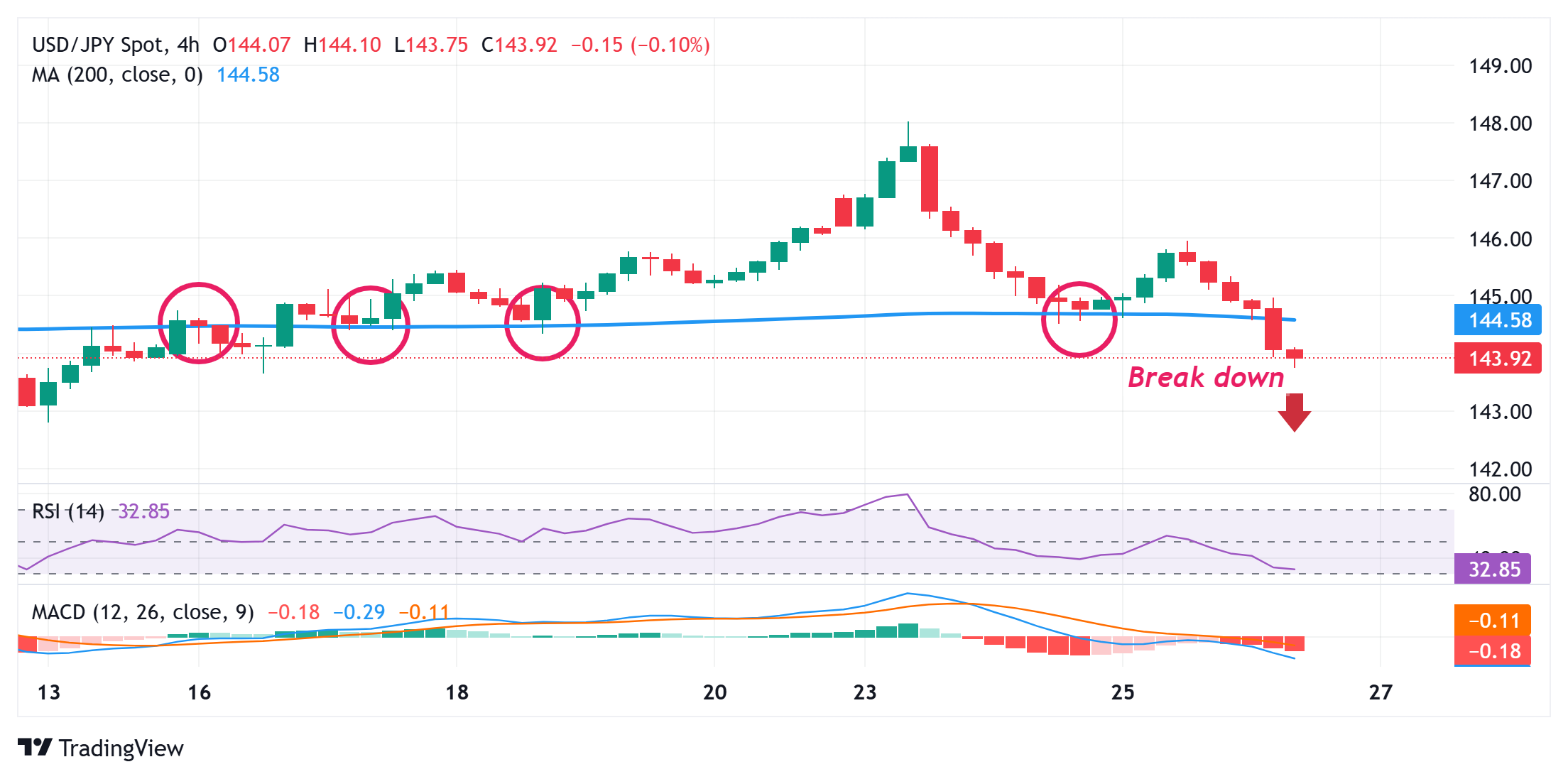
- USD/JPY attracts heavy selling and is pressured by a combination of negative factors.
- Concerns over the Fed’s independence weigh on the USD and lift the safe-haven JPY.
- The divergent Fed-BoJ policy expectations contribute to the steep intraday decline.
The USD/JPY pair resumes this week’s sharp retracement slide from the 146.00 mark, or its highest level since May 13, and dives to a one-and-half-week low during the first half of the European session on Thursday. Spot prices slip below the 144.00 mark in the last hour and seem vulnerable to weaken further amid a bearish fundamental backdrop.
US President Donald Trump escalated his criticism of Federal Reserve Chair Jerome Powell for not cutting rates and floated the idea of firing him. Powell, testifying before Congress for the second day on Wednesday, acknowledged that the recent inflation reading had been more moderate, but he warned that new tariffs could change that. Powell reiterated that the central bank is well-positioned to wait to cut interest rates until they have a better handle on the impact of Trump’s trade policies on consumer prices.
Meanwhile, reports suggest that Trump was considering naming Powell’s successor by September or October, stoking concerns over the central bank’s independence. When asked if he is interviewing candidates to replace Powell, Trump said he has three or four people in mind as contenders for the top Fed job. This, along with bets that the US central bank could resume its rate-cutting cycle as soon as July, drags the US Dollar (USD) to its lowest level since March 2022 and is seen weighing heavily on the USD/JPY pair.
Moreover, traders have fully priced in that the Fed will lower rates by at least 50 basis points before the end of this year. In contrast, the Bank of Japan – although has been hesitant to raise interest rates – is still expected to stay on the path of monetary policy normalization as inflation persistently exceeds its target. Japan’s core inflation has remained well above the BoJ’s 2% target for well over three years and rose to a more than two-year high in May. Furthermore, Japan’s Corporate Services Producer Price Index – a leading indicator of consumer price inflation – has been trending above the 3% YoY rate for several consecutive months.
The divergent Fed-BoJ policy expectations turn out to be another factor exerting downward pressure on the USD/JPY pair and validate the near-term negative outlook. Traders now look forward to the US economic docket – featuring the final Q1 GDP print, the usual Weekly Initial Jobless Claims, Durable Goods Orders, and Pending Home Sales. Apart from this, speeches from influential FOMC members could provide some impetus to the pair ahead of the Tokyo CPI and the US Personal Consumption Expenditure (PCE) Price Index on Friday. Nevertheless, the aforementioned factors suggest that the path of least resistance for spot prices is to the downside.
USD/JPY 4-hour chart

Technical Outlook
The overnight failure ahead of the 146.00 mark and a subsequent break below the 144.70-144.65 area, or the 200-period Simple Moving Average (SMA) on the 4-hour chart, validates the negative outlook for the USD/JPY pair. Moreover, oscillators on hourly/daily charts have just started gaining negative traction and back the case for a slide towards intermediate support near the 143.70-143.65 region en route to sub-143.00 levels.
On the flip side, the 200-SMA support breakpoint, around the 144.65-144.70 zone, now seems to act as an immediate hurdle ahead of the 145.00 psychological mark and the 145.25-145.35 static barrier. A sustained strength beyond the latter could allow the USD/JPY pair to make a fresh attempt to conquer the 146.00 mark. The said handle might now act as a pivotal point, which if cleared could shift the near-term bias in favor of bulls and pave the way for additional near-term gains.
Information on these pages contains forward-looking statements that involve risks and uncertainties. Markets and instruments profiled on this page are for informational purposes only and should not in any way come across as a recommendation to buy or sell in these assets. You should do your own thorough research before making any investment decisions. FXStreet does not in any way guarantee that this information is free from mistakes, errors, or material misstatements. It also does not guarantee that this information is of a timely nature. Investing in Open Markets involves a great deal of risk, including the loss of all or a portion of your investment, as well as emotional distress. All risks, losses and costs associated with investing, including total loss of principal, are your responsibility. The views and opinions expressed in this article are those of the authors and do not necessarily reflect the official policy or position of FXStreet nor its advertisers. The author will not be held responsible for information that is found at the end of links posted on this page.
If not otherwise explicitly mentioned in the body of the article, at the time of writing, the author has no position in any stock mentioned in this article and no business relationship with any company mentioned. The author has not received compensation for writing this article, other than from FXStreet.
FXStreet and the author do not provide personalized recommendations. The author makes no representations as to the accuracy, completeness, or suitability of this information. FXStreet and the author will not be liable for any errors, omissions or any losses, injuries or damages arising from this information and its display or use. Errors and omissions excepted.
The author and FXStreet are not registered investment advisors and nothing in this article is intended to be investment advice.








